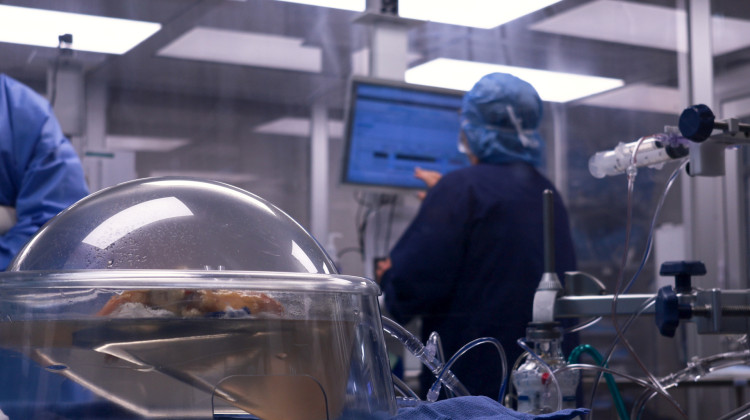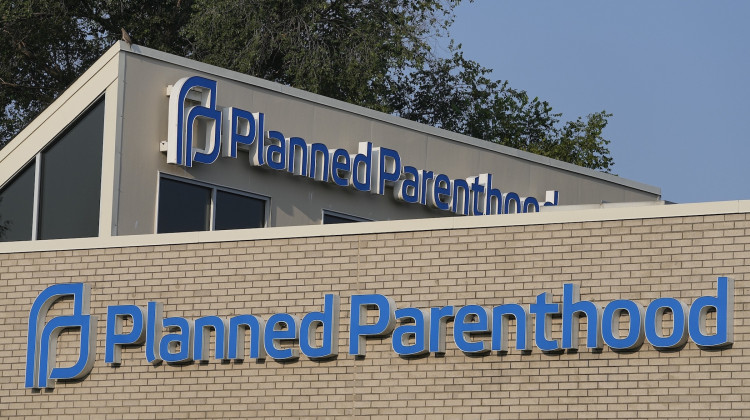
Over 101,000 Americans need a kidney transplant, but only 17,000 people receive one each year due to a donated organ shortage.
Zach Bundy / WFYISylvia Miles was diagnosed with lupus in 2006, a chronic autoimmune disease that causes the body's immune system to attack healthy tissue — including her kidneys.
Miles, who lives in Indianapolis, was later diagnosed with advanced kidney disease, and was in need of a kidney transplant.
Kidney diseases are one of the leading causes of death in the United States with 37 million people living with chronic kidney disease. Together with advanced kidney disease — the later stage of CKD — it cost Medicare billions of dollars in recent years.
People like Miles, who need a kidney transplant, wait an average of five years — often on dialysis.
But despite the long waitlists and organ shortages, around 9,000 kidneys from deceased donors last year were discarded due to perceived issues with their viability. A new Indiana-based organization, 34 Lives, is working to limit that waste and rehabilitate the organs.
More than 100,000 patients are on the national kidney transplant list and around 30 people are taken off the lists everyday because they either became too sick for a transplant, or died.
Miles was living in fear and uncertainty.
“The waiting period of just knowing whether or not I was going to get a transplant — if I was going to die before I was able to get a transplant,” Miles said, “was very nerve-wracking.”
Her life finally changed when she received one of the kidneys salvaged by 34 Lives.

How kidney donations work
Kidney donations come from two sources: living donors and deceased donors.
A living donor kidney is the best option for patients with kidney disease because the organs are typically better matches, healthier and last longer than a deceased donor kidney. But most patients get a kidney donation from a deceased donor through a waitlist system.
The deceased donor kidney is removed from the body, put on ice inside a styrofoam cooler, then an organ procurement organization transports it to a hospital where it’s needed.
That’s when a clock starts ticking. The longer the organ is outside the body, the higher the chances things can go wrong with it.
Transplant surgeons can get a small biopsy of the organ, imaging and some medical information from the donor. But that’s not always enough information, said Dr. Leonardo Riella, a transplant nephrologist with Massachusetts General Hospital.
“These biopsies are processed very quickly, meaning we cannot do all the stains to look at all the different aspects of the kidney,” Riella said. “We may not be able to actually say what's going on with the rest of the kidney because sometimes things can be spotty in terms of how they affect the kidney.”
The limited information, combined with the short timeframe an organ can stay outside the body, makes it harder for surgeons to be certain the kidney would work efficiently, or at all, once transplanted. This leads surgeons to decline kidneys — some of which may have been healthy enough to use.
Hospitals don’t have the funds or resources to repair damaged organs. Since the Food and Drug Administration hasn’t approved a process for repairing kidneys, a hospital would have to conduct a research study, which can cost hundreds of thousands of dollars.
So, if a kidney can’t be transplanted, it’s discarded.

Working to limit organ waste
34 Lives — named after the number of people who are removed from the transplant waitlist every day due to the progression of disease or death — is a public benefit company that is running an observational study, which uses a life support machine to try to preserve kidneys that would otherwise be discarded. The company is housed at Purdue University’s Research Park in West Lafayette, Ind.
“Every kidney transplanted into a patient saves Medicare about $2.5 million,” said Chris Jaynes, co-CEO of 34 Lives.
He said they saved the government over $160 million in the first 10 months of operation.
“We put [the kidney] on a little life support machine that allows us to warm it back up to body temperature,” Jaynes said. “And the reason why we do that is because as it's warm, we almost trick it into thinking it's still inside a body, and it can start working and functioning just like it was inside a body still.”
The life support machine allows 34 Lives’ staff to run nearly three dozen tests to determine how much sodium, potassium and urine a kidney is producing, and provide a kidney with nutrients, like sugar, so it’s able to heal itself.
A typical kidney can stay outside the body for just 24 to 36 hours. But the observational study team has added nearly 20 extra hours to that timeframe.
Since hospitals only run a limited amount of tests, some healthy kidneys can be overlooked, Jaynes said.
“Which is unfortunate, but that's how the system works right now,” he said.

The impact isn’t just at the patient level. Since 1973, Medicare has covered the cost of dialysis and kidney transplantation for patients with renal diseases, regardless of someone's age. Now, kidney disease and transplants are a third of Medicare’s outpatient budget.
So far, 34 Lives has been able to get 83 kidneys to transplant surgeons who transplanted them into patients at nearly a dozen hospitals across the country, including in Indiana, Ohio, Illinois, Wisconsin, North Carolina, Arkansas, New York and Massachusetts.
Sylvia Miles of Indianapolis received 34 Lives’ fifth kidney.
“I tell you, I feel amazing,” Miles said. “I haven't had a flare up since I had the transplant, which is a great deal for me.”
34 Lives hopes to save 50% of seemingly unuseable kidneys over the next five years through their project, “No Kidney Left Behind.”
They recently received a $44 million award from the Advanced Research Projects Agency for Health, a federal investment agency.
“Imagine a future where we didn't have to do dialysis at all because we had enough kidneys for everybody,” said Dr. Renee Wegrzyn, the director of ARPA-H at the time. “We can turn around somebody in crisis who needs a kidney [with]in days to weeks, then release that money into the economy.”
Although this research could move the needle, addressing the organ discard rate will only help a fraction of people who need a new kidney. Nephrologist Leonardo Riella said the issue also needs to be addressed in two other ways.
“One is reducing barriers for living donations so there are more living donors around,” Riella said. “And then, of course, is xenotransplantation. So looking for organs from other species that can be genetically modified to try to close the gap.”
But it could still be years before scientific research can lead to enough kidneys for every patient.
Contact WFYI’s health reporter Elizabeth Gabriel at egabriel@wfyi.org.
Side Effects Public Media is a health reporting collaboration based at WFYI in Indianapolis. We partner with NPR stations across the Midwest and surrounding areas — including KBIA and KCUR in Missouri, Iowa Public Radio, Ideastream in Ohio and WFPL in Kentucky.
 DONATE
DONATE






 Support WFYI. We can't do it without you.
Support WFYI. We can't do it without you.